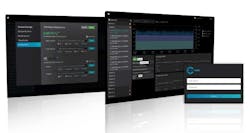Things will be different at the edge of the network. Providing bandwidth and data storage for distributed technologies like the Internet of Things, virtual reality and autonomous cars will require new types of facilities and the software to tie them together.
That’s the vision driving Vapor IO, a startup focused on optimizing data centers to support edge applications. The company today announced Vapor Edge, a software suite to provide “lights out” management of data and facilities, along with tight integration with cloud platforms.
Vapor’s announcement reflects the growing focus on edge computing, which moves content closer to users, improving the experience for streaming video and gaming. It’s a trend that has huge implications for Internet infrastructure, which traditionally has been focused on major markets.
Mobile computing has changed the game. For data center providers, success in second-tier markets requires building in the right place, and at the right size.
Vapor IO is among the companies focused on this challenge. It’s a software company, but has also designed an unusual round IT enclosure called the Vapor Chamber. CEO Cole Crawford says the combination of Vapor Edge software and the Vapor Chamber can slash the cost of data center construction, improving the economics of deploying capacity in remote locations.
Eliminating the Generator and UPS
Vapor’s technology aims to eliminate the need for on-site staff and expensive backup equipment like generators or centralized UPS systems. Its software moves content across the network to optimize for both latency and resiliency, shifting assets closer to the user when needed.
In the event of a power outage, the Vapor Chamber’s on-board battery keeps the IT assets online while data is backed up to a cloud platform or data center.
Crawford says this approach is ideal for remote data facilities handling edge content, and can be cheaper than traditional data center construction. Crawford says companies using Vapor Edge with the Vapor Chamber can deploy new capacity at $3 million per megawatt, compared to the $5 million to $6 million deployment cost for the largest hyperscale data center builders.
“We’re doing this at half the cost of the best companies on the planet,” said Crawford.
Rethinking Design, From the Ground Up
That seems like an audacious claim. Crawford knows a bit about disruption from a stint as Executive Director of the Open Compute Project, which used open source hardware designs to create a new generation of servers and storage for hyperscale data centers. Crawford says Vapor involved a similar process of rethinking conventional wisdom.
“If we built an edge data center from scratch, from mud to cloud, what would it look like?,” said Crawford. “How do we do this at the edge? We had to build the physical environment that can sit at the edge of the network to deliver low-latency experiences to the world. We started looking at how we build data centers.”
The result is a cloud-centric approach guided by the latency and data flows of emerging technology. Vapor Edge will optimize the movement of data between edge nodes, centralized data centers and the cloud.
“The cloud as we know it is changing,” said Crawford. “For the last decade, it’s been dominated by large, centralized data centers. But there is an emerging class of applications – including IoT, virtual and augmented reality, and mobile apps – where centralized data centers simply won’t work because compute, storage, and network capacity need to be near the application or device. With Vapor Edge, we’re paving the way for a truly decentralized data center and enabling edge cloud computing.”
Vapor isn’t alone in targeting the edge computing opportunity. Others pursuing this market include EdgeConnex, which has built a national network of unmanned data centers to provide content distribution in secondary markets. Like Vapor IO, the EdgeConneX model is supported by sophisticated software to provide remote management of data and facilities.
These efforts don’t yet extend far enough, says Crawford, who believes that virtual reality mobile apps and autonomous cars will drive content ever closer to the user, extending infrastructure into even smaller markets. Its approach has impressed the Open Compute Project, which includes many hyperscale data center operators.
“Vapor is taking a very sophisticated approach to enabling edge networks,” said Corey Bell, CEO of the Open Compute Project. “They are connecting to the underlying hardware in new ways to solve key challenges, such as remote operation and workload migration. This has always been a vision shared by the Open Compute Project and we are excited to see Open Compute hardware play a vital role in making edge computing practical, as customers deploy OCP accepted and inspired hardware in Vapor Edge environments.”
Vapor Edge Components
Vapor Edge consists of both software and hardware designs that Vapor IO licenses to partners. Here’s an overview:
- Vapor CORE software can remotely monitor and administer data center environments. It tracks centralized data center and edge machines, ingests hardware telemetry in real time, and provides tools to remotely view and manage their edge operations.
- Vapor Compass software creates automated command-and-control policies for managing workloads in distributed edge environments. Compass is designed to make real-time optimization decisions, including rescheduling workloads onto edge nodes or centralized data centers, based on policies, including latency and cost.
- Vapor Chamber: Operators can use Vapor Chamber design, a circular racking system that is tightly integrated with Vapor Edge software, and ideal for use in cell towers or rooftops.
The Vapor Chamber enclosure from Vapor IO houses six racks in a round enclosure with a central “hot aisle.” (Photo: Vapor IO)
Each Vapor Chamber can support six racks positioned in a ring. Cool air enters from the exterior, and waste heat is contained in a central vertical column, allowing airflow to be managed with minimal use of fans. The enclosure features an on-board battery, modular rectifiers, and fire suppression. It doesn’t require a raised floor environment or room-level coolimg, but can live outdoors and operate in extended heat and humidity ranges.
“It just needs to be protected from the rain,” said Crawford. Vapor IO has partnered with modular data center builder BASELAYER to provide an integrated solution for users to deploy Vapor Chambers in remote sites.
Vapor IO’s software is built atop the Open Data Center Runtime Environment (OpenDCRE), an open source protocol it created to monitoring data center hardware, software and environmental characteristics. The company says Vapor Edge can integrate with public clouds, such as Amazon Web Services and Microsoft Azure, as well as popular private clouds like OpenStack and VMware Vsphere, as well as with modern container-driven systems, such as Mesosphere’s DC/OS and the Cloud Native Computing Foundation’s Kubernetes.
Before embracing a new design, many data center operators first like to see it running in someone else’s facility. Seeing the full Vapor Edge solution in action may mean a trip to the Czech Republic, where Centrepointe has partnered with Vapor IO to build DataHub Verne, a 200 megawatt project in Prague that is the first announced customer.
Crawford says Vapor IO is actively working with a customer that could showcase the distributed capabilities of Vapor Edge in small remote data centers. He isn’t offering details yet.
A REIT-Ready Solution?
Crawford notes that there are many real estate investment trusts that generate revenue by leasing cell towers or space on rooftops, two use cases for Vapor Edge deployments.
“Most of the colo companies and data center companies are REITs,” said Crawford. “Clearly a REIT that might also have dark fiber and land and towers would be a fantastic relationship for us.”
Another opportunity is verticals that will require low latency at the edge, including virtual reality, augmented reality or autonomous cars.
Crawford says Vapor IO isn’t interested in creating its own network. “We’re software guys,” he said. “We think about the data center as code. We don’t want to compete as an operator.”
While there are multiple options, Crawford is convinced that edge computing will drive disruption.
“Data is so prevalent that we have to move the compute to the data, rather than moving all the data to the compute,” he said.
Explore the evolving world of edge computing further through Data Center Frontier’s special report series and ongoing coverage.






